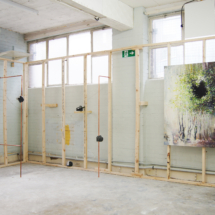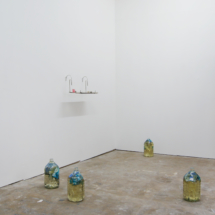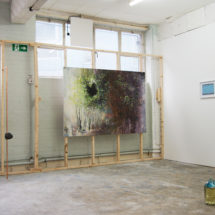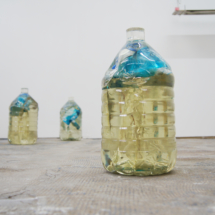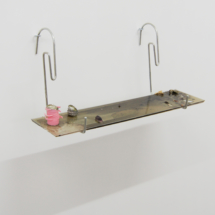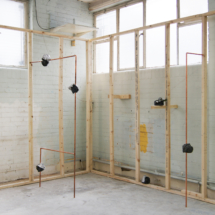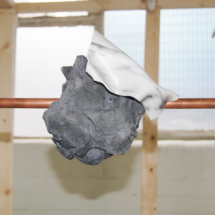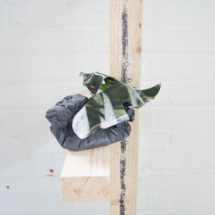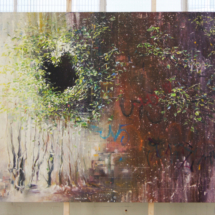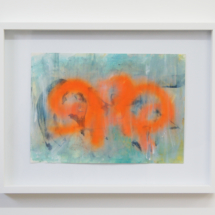The Bullet Returns to Where the Shot was Fired II
Patrick Goddard
Mia Goyette
Felicity Hammond
Hyojun Hyun
curated by Àngels Miralda
Exhibition: 7-29 October 2016
13-19 Herald Street
London
Set.
Berlin.
Soft autumnal winds flow down the canal by Schöneberger Ufer. A street famous for its galleries that started moving to Schöneberg around 2008, the same time as the first Art Berlin Contemporary. House of Egorn has occupied a small white cube in a newly de- veloped building for 1 year. I looked back to 2008 on google maps and found an awkward- ly similar building standing here before the current reincarnation. The old one was falling apart, it was very weathered ABC fair attracts hundreds of visitors to the neighbourhood every September. This is one of the two important weeks on the Berlin art calendar. The exhibition will open during Ber- lin Art Week along with many other galleries in the area.
London.
The crashing sounds of construction blare onto Herald Street. A street that, in some way, defined the term ‘East End galleries’. New galleries are popping up with time. House of Egorn London Lounge, our two-month-long pop-up, occupies a small DIY-partitioned cube in a shared warehouse with other younger galleries as well as studio spaces for artists. Before being a spot for galleries and artists, this used to be a community church, and years before that, Wolfgang Tillmans’ studio. Now it is an in-between space being used temporarily by its current incumbents until redevelopment can begin.
Frieze is one of the most important internati- onal art events. Every week is London’s most important week, and everyone looks tired and overworked. The exhibition will open during the East End Gallery Night along with many other galleries in the area.
Works.
Berlin.
Mia Goyette creates casts of hands, bottles, structures, and records the pas- sing of time through the act of collecting. We are interlinked with the world around us chemically but also financially as seen by the consumer goods that accompany our daily lives. Liquid is an essential part of life and the case or vessel connects us biologically to the packages that we consume and inhabit.
The prospect of an end [Sedimentary Deposition]. reminds me of all those abandoned developments where const- ruction was halted after the housing crash. Streets and pavements leading to nowhe- re, streetlights that illuminate the decaying concrete subject to natural processes of growth. Goyette connects the models with pipes in the Kunstverein Nürnberg but here it stands alone or as an island. The ti- tle stems from the work of geologist James Hutton who developed the category of “Anthropic Rock.” Concrete, although a man-made aggregate, decays at a similar tempo to natural rock and creates these skeletons of houses that are that remains after everything else has been stripped away.
Vom Gipfel des Berges are resin casts made from the insides of plastic water bottles. The plastic is stripped away but the water is polluted by its own marketing. Water becomes a stamped and branded commodity and the jar takes on this double purpose of carrying and identifying the water. The resin cast that places the water at once conserves the brand forever and makes it illegible. The water is sold as coming from a pure source in high-altitude mountains but then is then captured and sold for human subsistence.
London.
Felicity Hammond presents a drooping installation made of a multitude of construction materials connecting dispa- rate elements. The grey composite rock is made from stolen ballasts from a new development not far from the artist’s studio. Mixed to create a strong concre- te, it severs its own function. Rather than creating the pillars that form the backbo- nes of houses, it creates an unstable and precarious structure. It casts an unneces- sary weight on a fragile connection of exposed piping. Pipes should be covered and protected by the concrete. Hence the installation could be read as inside-out.
A shallow pool lies at the bottom of a pipe. This grey and glossy material appears as a leak in the drainage. Something awry, an oil spill, a black mirror, a filthy puddle.The backdrop is a photograph from the new constructions at the Royal College of Art in London overset with a gradient wash ins- pired by real estate brochures from luxury developments.
London.
Patrick Goddard directs our attention to one light bulb over the duration of 6 minu- tes. Through a casual dialog over a cup of coffee, an everyday object’s significance is discussed in a wider context. Emulating candlelight in order to achieve a designed light intensity, it signals something vintage and thought through. It sacrifices its own functionality and signals an over-abundan- ce of curation. An aesthetic of the authen- tic is exposed as a contradiction through its obsession with its own image. The camera never moves off the light bulb. It stares intensely at the glowing tungsten in a hand-held pixelated aesthetic that in turn makes fun of and contradicts itself. North Sea at Noon is made of a heavy sys- tex security screen used to protect unoc- cupied buildings from being squatted. It was repurposed as a colour-field painting and meticulously scrubbed down to expose layers of paint that have been ap- plied to the systex structures by different companies. An unintentional monochro- me is created. Rust comes through the paint and corrodes the material that was designed to prevent the corrosion of the spaces it protects.
Berlin.
Hyojun Hyun perceives a composition in a rusted wall. There is an art historical precedent for the abstractions created subconsciously by the natural world, as if an industrial modernism had designed the stain. The detail expands, joins others, and together they create figures and lines. Hyun’s eye for compositions picks up on abandoned leftovers, and lifts them into the realm of art. A carefully executed painting meticulously developed over long periods of time cre- ates a trompe-l’oeil. But the brush is also its own master. A drip of paint pollutes the canvas. Just like the incessant drip of water drops from the kitchen sink which eventually mark the ceramic surface, the paint drops and creates a stain. An ela- borate stain that then becomes the filter, overturning the perfection of painting. Venus shows the remains of a ripped pos- ter with a posing female body. The body has become an image whose flatness and beauty is threatened by the sun and the effects of time. The figure stands out from the abstract composition of exposed white fibers of the paper. It is an abandoned human body in a mire of decaying colours. Gravity focuses on the detail of a wooden structural support on a flat brick wall. The brick wall is typical of Belgian homes whe- re this fragment was found. Time destroys the safety of the private surroundings and the support stands as a testament to the fallibility of even the soundest structures. Nowhere is left against an unpolished wall. Like the remains and scratches in the brickwork, the support for the work is also stained and punctured through the causality of previous installations.
The title refers to the film Is the Museum a Battlefield from Hito Steyerl, presented at the 2013 Istanbul Biennial. In the performance lecture she claims that architecture works as a signal that reveals where a metaphorical weapon has recoiled. In other words, the extreme gentrification and renovation of certain areas must be seen as the product and spolia of assets gained through war. Her final thesis reveals the inter- connected role of artists within this global system as she turns the camera around to reveal herself as the shooter.
This exhibition explores how artists place themselves within this complex ecology and work within it - using irony and contemplation. Taking place in two different locations that are heavily interconnected regarding artistic movement, but also redevelopment and gentrification, we see how artists respond to the ever-changing contexts of Lon- don and Berlin.
text by Àngels Miralda
